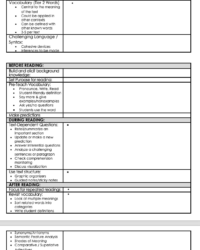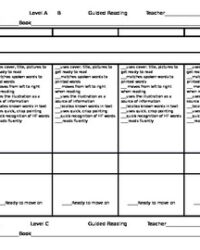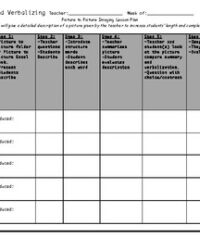Crafting an effective lesson plan is often seen as the cornerstone of successful teaching. It is the roadmap that guides both educators and students through the learning journey, ensuring that objectives are met and understanding is solidified. Without a clear plan, lessons can sometimes drift, leaving learners feeling disconnected from the core concepts.
This is precisely where a structured approach, like the renowned 5 part lesson plan template, proves invaluable. It provides a logical flow that caters to various learning styles and stages of comprehension, making complex topics more accessible and engaging for everyone in the classroom. Embracing this framework can transform your teaching, bringing clarity and purpose to every minute of instruction.
Understanding the Core Components of a 5 Part Lesson Plan
The 5 part lesson plan, often referred to as the “5 Es” model, is a highly effective instructional design widely used in education, particularly in science and inquiry-based learning. It is designed to move students through a progressive sequence of learning, from initial engagement to deep understanding and application. This model encourages active participation and critical thinking, fostering a more meaningful educational experience. Each “E” builds upon the last, creating a cohesive and comprehensive learning cycle.
It’s about more than just delivering information; it’s about facilitating discovery and ensuring that learning is truly embedded. This structured approach helps teachers anticipate student needs and potential misconceptions, allowing for more targeted and responsive instruction. By systematically addressing each phase of learning, educators can feel confident that they are providing a well-rounded and impactful lesson.
Engage: Hooking Your Learners
This is the phase where you capture students’ attention and pique their curiosity about the topic. The goal is to connect with their prior knowledge and experiences, setting the stage for what they are about to learn. Activities in this stage might include a thought-provoking question, a short video, a real-world scenario, or a demonstration that sparks intrigue. It’s all about creating a mental hook that makes students want to delve deeper into the subject matter.
Explore: Hands-On Discovery
Once engaged, students move into the exploration phase where they actively investigate the concept. This is where hands-on activities, experiments, group discussions, or problem-solving tasks come into play. The teacher acts as a facilitator, guiding students as they gather information, make observations, and formulate questions. This phase encourages collaborative learning and allows students to construct their own understanding through direct experience, rather than simply being told the answers.
Explain: Building Understanding
After exploration, students are ready to formalize their understanding. In the explain phase, the teacher steps in to clarify concepts, provide definitions, and introduce new vocabulary. This is where direct instruction often occurs, but it’s done in response to the students’ prior explorations. The teacher helps students connect their experiences from the explore phase with academic language and established scientific or conceptual principles. It’s a two-way street, with students sharing their findings and the teacher consolidating their knowledge.
Elaborate: Applying Knowledge
The elaborate phase challenges students to apply their newly acquired knowledge and skills to new situations. This could involve solving more complex problems, conducting further research, designing a project, or engaging in debates. The aim is to extend their understanding, make connections to other concepts, and demonstrate their ability to use what they’ve learned in different contexts. This stage deepens comprehension and allows students to see the relevance and broader implications of the topic.
Evaluate: Assessing Progress
Finally, the evaluate phase serves as an opportunity for both teachers and students to assess understanding and progress. This can be done through various methods, including formal assessments like quizzes or tests, informal observations, student presentations, rubrics for projects, or self-reflection journals. It provides valuable feedback on how well students have grasped the concepts and helps identify areas for further instruction or individual support. It’s a crucial step for measuring learning outcomes and planning future lessons.
Why Embrace the 5 Part Lesson Plan Template in Your Teaching?
Adopting the 5 part lesson plan template offers numerous advantages for both educators and students, transcending various subjects and grade levels. For teachers, it provides a clear, consistent framework that reduces planning time once familiar with the structure, ensuring that all crucial stages of learning are addressed systematically. This leads to more organized and confident delivery, as the progression from engagement to evaluation is thoughtfully mapped out. Students, in turn, benefit from a predictable yet dynamic learning environment that fosters deeper understanding and retention.
This template inherently promotes a student-centered approach, encouraging active participation and critical thinking at every turn. Instead of passively receiving information, learners are guided to explore, question, and construct their own knowledge. This active involvement not only makes learning more enjoyable but also more effective, as students take ownership of their educational journey. It’s about building a solid foundation, brick by brick, rather than just laying down a superficial layer of facts.
The flexibility of the 5-part model also allows for adaptation to diverse classroom needs and subjects, making it a truly versatile tool. Whether you are teaching science, history, or language arts, the core principles of engaging, exploring, explaining, elaborating, and evaluating remain universally applicable.
- Facilitates a natural progression of learning.
- Boosts student engagement and active participation.
- Provides clear structure for both teacher and student.
- Allows for effective differentiation and assessment.
- Promotes deeper understanding and retention of concepts.
Ultimately, integrating this framework into your teaching repertoire can significantly enhance the quality of your lessons, making them more impactful and memorable for every learner.
Utilizing a structured approach to lesson design can truly revolutionize the classroom experience. It moves beyond simple instruction to create a dynamic environment where curiosity is nurtured, exploration is encouraged, and deep understanding is built step by step. This thoughtful planning ensures that every minute of class time is purposeful, leading to measurable growth and a more confident, capable student.
By providing a clear roadmap for both teaching and learning, this systematic framework empowers educators to deliver content with precision and passion, while equipping students with the tools to truly master new concepts. It’s an investment in effective pedagogy that pays dividends in genuine comprehension and lasting knowledge.


